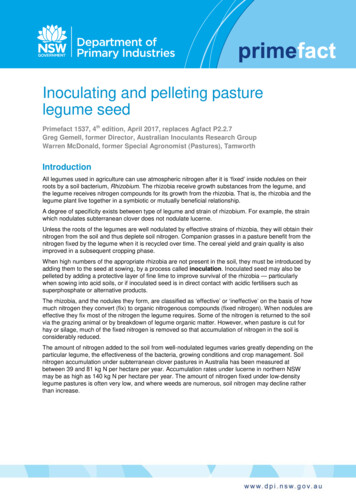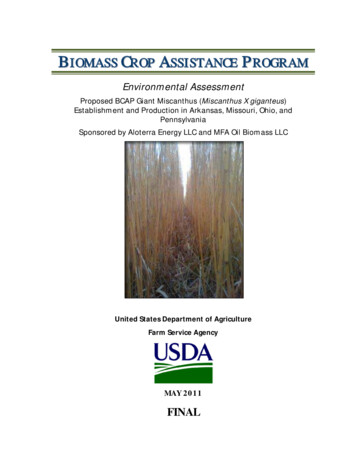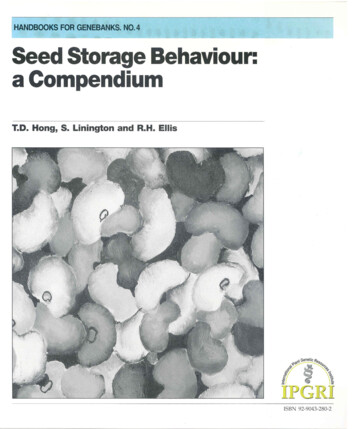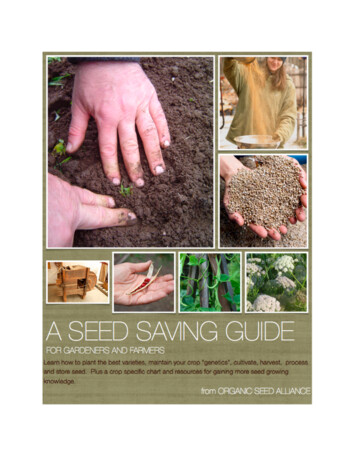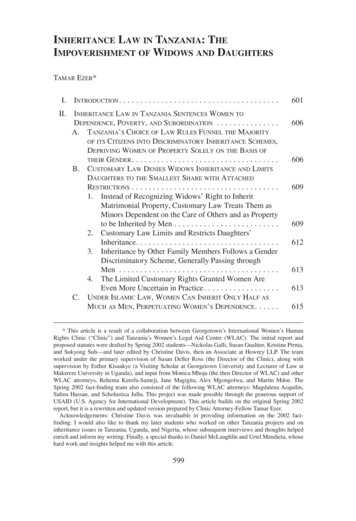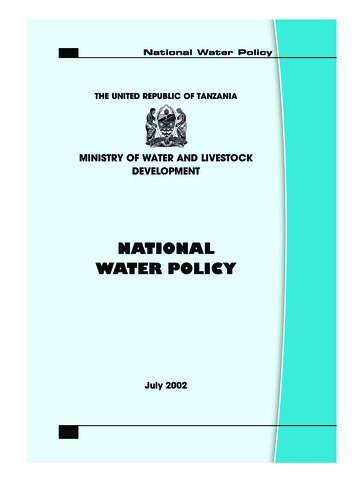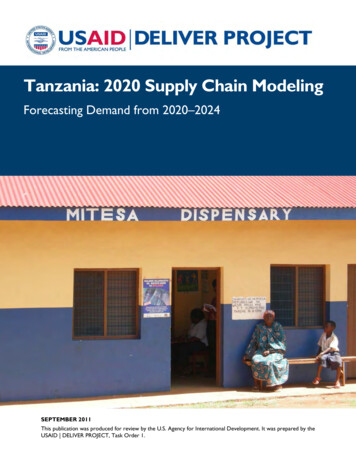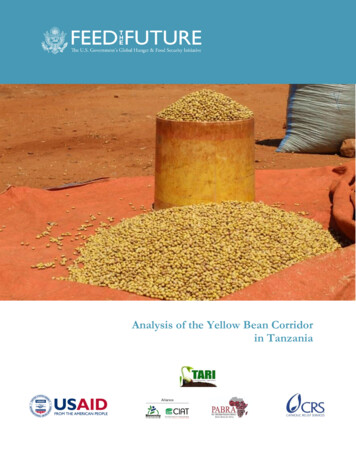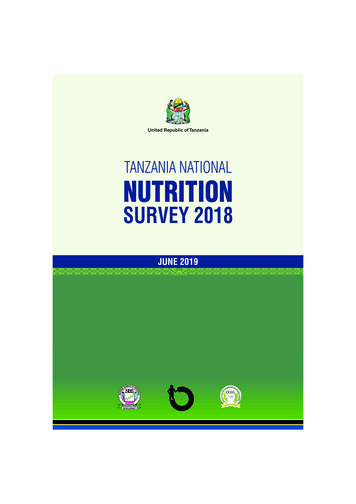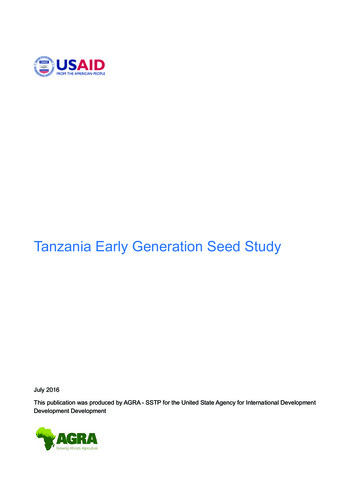
Transcription
Tanzania Early Generation Seed StudyJuly 2016This publication was produced by AGRA - SSTP for the United State Agency for International DevelopmentDevelopment Development
FOREWORD .IIIACKNOWLEDGEMENTS . IVTERMINOLOGY . VIEXECUTIVE SUMMARY . IXCHAPTER 1: CURRENT SITUATION – DOMINANT SEED SYSTEMS .XIV1.1Country overview .XIV1.2Agriculture sector .XVI1.3Dominant seed systems in Tanzania.51.4Key actors in the seed systems .7CHAPTER 2: CURRENT SITUATION - PRIORITY CROPS FOR EGS STUDY .132.1FRAMEWORK FOR PRIORITISATION .13CHAPTER 3: CURRENT SITUATION-EGS SYSTEMS .163.1Maize.163.2Sorghum.283.3Common beans .333.4Cassava.40CHAPTER 4: ECONOMIC ANALYSIS .474.1Potential Early Generation Seed demand .474.2Production cost of Early Generation Seed .534.3 Eary Generation Seed matched with revenue/cost .56CHAPTER 5: EARLY GENERATION SEED OPERATION STRATEGIES .625.1Optimal market archetype .625.2Key challenges .645.4Public Private Partnership mechanisms and solutions .655.5Public hybrid and OPV maize .665.6common bean and OPV sorghum .675.7Cross-cutting recommendation .705.8Crop specific recommendation.715.9Common bean and opv sorghum .715.10Cassava5.11Public hybrid and OPV maize .72.71BIBLIOGRAPHY .74Tanzania EGS Final ReportI
IITanzania EGS Final Report
FOREWORDThe United States Agency for International Development (USAID) and the Bill and Melinda GatesFoundation (BMGF) recognized that many bottlenecks hinder projects targeting smallholder farmersin sub-Saharan Africa (SSA), including the unsustainable supply of Early Generation Seed (EGS);poor functioning of national variety release systems; outdated seed policies, laws and regulations,and misplaced subsidies that limit access to publicly developed improved varieties by private seedcompanies. These bottlenecks have resulted in the continuing presence of obsolete varieties in seedmarkets, as well as counterfeit seeds.Over the past two years, the USAID and BMGF partnership has explored, with a large number ofnoted US, African, and international technical experts, how to address constraints in EGS systems.This exploration led to the development of a methodology to analyze seed value chains by specificmarket, crop, and economic dimensions. Applying this methodology leads to identifying the actorsand actions along the seed value chain that are required to produce adequate EGS on a sustainablebasis. Technical experts from African regional organizations, research and technical agencies, anddevelopment partners vetted the methodology.The Context Network contracted by AfricaLead II led a one-day EGS technical training on how toimplement the study methodology with researchers from 11 countries, in Addis Ababa, Ethiopia, onFebruary 27, 2016.AGRA through the SSTP program contracted country consultants and coordinated the studyimplementation in Ghana, Malawi, Mozambique and Tanzania.Each country study required careful consideration of appropriate private, public, donor, NGO, andinformal sector roles in seed distribution to end-users. An inclusive set of stakeholders who stretchbeyond a short “seed only” value chain (i.e., from breeder to foundation seed producers to producersof certified and quality declared seed (QDS)), were consulted. The country studies aim to understandfarmer requirements, such as demand, independently of the policy and technical parameters affectingEGS supplies.The studies will create incentives for greater government and private investments in the respectiveseed sectors, laying the basis for increased scale-up and adoption of more productive technologies.With short-term increase in the supply and quality of EGS, a number of policy or investment constraintswill come into focus, coalescing stakeholders around the downstream changes required to addressthe constraints hindering seed quality and supply.-Tanzania EGS Final ReportIII
ACKNOWLEDGEMENTSThe Tanzania EGS study was developed by Emmarold Mneney and Oswald Mashindano under thetechnical guidance of Latha Nagarajan, an agricultural economist with IFDC, who was contractedby The Rutgers University Feed the Future Policy Research Consortium with logistic and technicalsupport from SSTP staff based both at AGRA headquarters and in Tanzania.The team would also like to thank all key stakeholders in Tanzania who participated in the planningand validation workshops as well as those who accorded the research team interviews for thisstudy.SSTP acknowledges the work of the Context Network in developing the infographics andtemplates, and in allowing these to be modified and used in this report.This report was made possible through support provided by USAID, under the terms ofCooperative Agreement No. AID-OAA-A-13-00040 managed by AGRA. The opinions expressedherein are those of the author(s) and do not necessarily reflect the views of USAID.IVTanzania EGS Final Report
AIDWEMAWFPAlliance for a Green Revolution in AfricaAgricultural Research InstituteAgricultural Seed AgencyAgricultural Sector Development ProgrammeAgricultural Sector Development StrategyBill and Melinda Gates FoundationComprehensive Africa Agriculture Development ProgramConsultative Group on International Agricultural ResearchInternational Centre for Tropical AgricultureInternational Maize and Wheat Improvement CentreDivision of Research and DevelopmentEarly Generation SeedEarly Generation Seed Public Private PartnershipGross Domestic ProductHectareInternational Crops Research Institute for the Semi-Arid TropicsInternational Sorghum and MilletInternational Seed Testing AssociationMinistry of Agriculture, Livestock and FisheriesMaize Leaf Necrotic DiseaseMetric TonNon-Governmental OrganizationsOrganization for Economic Cooperation and DevelopmentOpen Pollinated VarietyPublic Private PartnershipPlant Variety ProtectionQuality Declared SeedSouth African Development CooperationTanzania Agricultural Research InstituteTanzania Seed Trade AssociationTanzania Official Seed Certification InstituteInternational Union for the Protection of New Varieties of PlantsUnited Republic of TanzaniaUnited States Agency for International DevelopmentWater Efficient Maize for AfricaWorld Food ProgramTanzania EGS Final ReportV
TERMINOLOGYBreeder seed: Breeder seed is produced by or under the direction of the plant breeder who selectedthe variety. During breeder seed production the breeder or an official representative of the breederselects individual plants to harvest based on the phenotype of the plants. Breeder seed is producedunder the highest level of genetic control to ensure the seed is genetically pure and accuratelyrepresents the variety characteristics identified by the breeder during variety selection. Duringbreeder seed production the breeder or an official representative of the breeder selects individualplants to harvest based on the phenotype of the plants.Pre-basic seed: is the progeny of the breeder. Pre-basic seed is a class of seed between breederand foundation or basic seed that is used to produce sufficient quantities of seed for foundation orbasic seed production. It is the responsibility of the breeder to produce pre-basic seed and productionshould occur under very high levels of genetic control.Foundation or basic seed: Foundation seed is the descendent of breeder or pre-basic seed andis produced under conditions that ensure maintaining genetic purity and identity. When foundationseed is produced by an individual or organization other than the plant breeder there must be adetailed and accurate description of the variety the foundation seed producer can use as a guide foreliminating impurities (“off types”) during production. Foundation and basic seed are different wordsfor the same class of seed. Basic seed is the term used in Tanzania.Certified seed: Certified seed is the descendent of breeder, pre-basic, or basic seed producedunder conditions that ensure maintaining genetic purity and the identification of the variety and thatmeet certain minimum standards for purity defined by law and certified by the designated seedcertification agency.Quality Declared seed: In 1993 the Food and Agriculture Organization of the United Nations (FAO)produced and published specific crop guidelines as Plant Production and Protection Paper No. 117Quality Declared Seed – Technical guidelines on standards and procedures. The Quality DeclaredSeed (QDS) system is a seed-producer implemented system for production of seed that meetsat least a minimum standard of quality but does not entail a formal inspection by the official seedcertification system. The intent behind the QDS system is to provide farmers with the assurance ofseed quality while reducing the burden on government agencies responsible for seed certification.The QDS system is considered by FAO to be part of the informal seed system. However, in thecase of Tanzania, the FAO QDS system was modified and adopted in the year 2000. The QDS wasincorporated into the formal seed system in the national Seeds Act of 2003, along with its seed rules,regulations & procedures (2007).Quality seed: In this report the phrase quality seed is at times used in place of certified seed or QDSto describe a quality-assured seed source without specifying certified or QDS. Quality seed mustmeet the four basic parameters of seed quality which are: physical, physiological and genetic.Commercial seed: Any class of seed acquired through purchase and used to plant farmer fields.Improved versus landrace or local varieties: Improved varieties are the product of formal breedingprograms that have gone through testing and a formal release process. A landrace is a local varietyof a domesticated plant species which has developed over time largely through adaptation to thenatural and cultural environment in which it is found. It differs from an improved variety which hasbeen selectively bred to conform to a particular standard of characteristics.Formal seed system: The formal seed system is a deliberately constructed system that involves achain of activities leading to genetically improved products: certified seed of verified varieties. Thechain starts with plant breeding or a variety development program that includes a formal releaseand maintenance system. Guiding principles in the formal system are to maintain varietal identityand purity and to produce seed of optimal physical, physiological and sanitary quality. Certified seedmarketing and distribution take place through a limited number of officially recognized seed outlets,usually for sale. The central premise of the formal system is that there is a clear distinction between“seed” and “grain.” This distinction is less clear in the informal system.VITanzania EGS Final Report
Informal seed system: The informal seed system also referred to as a local seed system, is basedon farmer saved seed or QDS. Varieties in the informal system may be variants of improved varietiesoriginally sourced from the formal system or they may be landrace varieties developed over timethrough farmer selection. There is no emphasis on variety identity, genetic purity, or quality seed.The same general steps or processes take place in the local system as in the formal sector (varietychoice, variety testing, introduction, seed multiplication, selection, dissemination and storage) butthey take place as integral parts of farmers’ production systems rather than as discrete activities.While some farmers treat “seed” as special, there is not necessarily a distinction between “seed” and“grain.” The steps do not flow in a linear sequence and are not monitored or controlled by governmentpolicies and regulations. Rather, they are guided by local technical knowledge and standards and bylocal social structures and norms.MethodologyBuilding on previous studies and consultations with governments, private sector organizations, andpartners, the USAID and BMGF partnership developed, tested, and widely vetted a methodology toidentify country-specific and crop-specific options to overcome constraints in EGS supply (MonitorDeloitte EGS Study sponsored by USAID and BMGF in 2015). As illustrated in Figure 1, thismethodology includes ten-steps to define EGS systems, perform economic analysis, and developEGS operational strategies.Figure 1: EGS System ten-step process1ABCCURRENTSITUATIONECONOMICANALYSISDEFINE EGSSOPERATIONALSTRATEGIESDominant Seed Systems2Prioritized Crops3Current EGS Systems4Potential EGS Demand5Cost of EGS Production6EGS Demand Matchedwith Revenue/Cost7Optimal Market Archetype8Public-Private Partnership Mechanisms& Solutions9Recommendations &Investment Priorities10Key ChallengesSource: Ten steps based on process developed by Monitor Deloitte for EGS study (USAID and BMGF, 2015).The first six steps of this ten-step process were used to analyze specific crops within Tanzania in order toinform step seven, development of the optimal market archetype. The study commissioned by the USAID andBMFG partnership utilized a common economic framework to define public and private goods and applied it toEGS systems, as shown in Figure 2. Once the optimal market archetype for each crop was developed, stepseight through ten identified the key challenges to achieving the optimal market archetype, possible publicprivate partnership mechanisms and solutions, and final recommendations.Tanzania EGS Final ReportVII
Marginal economic value of quality seedof improved varietiesHighLevel of demand for crops grown withquality seed of improved varieties1Private Sector DominantArchetypeQuality seed of improved varieties that is bothHigh attractive for private sector actors to produce andthat produces crops the market demands,resulting in robust private sector investment withminimal public sector involvement3Public-PrivateCollaboration ArchetypeQuality seed of improved varieties for crops withstrong market demand but for which the cost ofproduction or demand risk create barriers toprivate-sector investment and innovation resultingin public sector involvement4Niche Private SectorArchetypeLowLow2Quality seed of improved varieties for crops withniche market demand but which are profitable toproduce in certain quantities, which are producedby a vertically integrated private sector withminimal public involvementPublic Sector DominantArchetypeQuality seed of improved varieties for crops thatare not highly desirable or profitable to produce,but which are promoted by the public sector toadvance a public goal such as food security orseed securityFigure 2: Market archetype frameworkSource: Framework developed by Monitor Deloitte for EGS study (USAID and BMGF, 2015).This framework categorizes EGS systems of crops and crop segments within a specific country,based on marginal economic value of the quality of improved varieties and the level of demand forcrops grown with quality seed of improved varieties. Several variables, as represented in Table 1,inform these two factors.Table 1: Variables that inform market archetype frameworkSource: Based on variables developed by Monitor Deloitte for EGS study (USAID and BMGF, 2015).Key VariableDescriptionExamplesMARGINAL ECONOMIC VALUE OF IMPROVED VARIETIESDifferential performanceof improved varietiesLevel with which improved varieties in the market havedifferential performance versus local varietiesYield, quality, traits such as disease anddrought toleranceFrequency of seedreplacementFrequency with which quality seed must be bought tomaintain performance and vigor of an improved varietyYield degeneration, disease pressure, pipelineof new varieties being commercialized regularlyDifferentiatingcharacteristicsExistence of differentiating characteristics that command aprice premium for improved varietiesPrice premiums for processing, nutritionalcharacteristicsFragility of seedAbility of seed to withstand storage and/or transport withoutsignificant performance lossHardiness/fragility of seedCost of producing quality seedMultiplication rates, input costs, laborrequirements, mechanization, macro and micropropagation technologyCost of quality seedproductionMARKET DEMAND FOR QUALITY SEED OF IMPROVED VARIETIESVIIITotal demand for seedHow much seed is required to meet the planting needs of agiven cropAreaRequirement for qualityassuranceRequirement for quality assurance to realize variety benefitsCertification, Quality Declared, farm-savedseedFarmer demand forspecific varietiesLevel of farmer demand for specific varietiesMainly driven by agronomic performanceMarket demand forspecific varietiesLevel of downstream demand for specific characteristicsColor, cooking quality, processing qualityTanzania EGS Final Report
EXECUTIVE SUMMARYThe Tanzanian seed system has grown over the years as observed from the increase in seedenterprises, improved seed support services and overall increased volumes of certified seed. Thereare five identified dominant seed systems in Tanzania, which include farmer-saved, public–private(local seed businesses), public (government driven), private international and private local. Thefarmer-saved and public seed system accounts for the majority of seed volume while the privatesector companies and public seed system contribute the majority of EGS.Despite the recent increase in use of certified seed in maize, rice, beans, sorghum, groundnuts andsesame production, the formal sector contributes only 25% of the seeds available in Tanzania. Theinformal seed system, which is estimated at about 75% of the seed market share (USAID 2013, URT2013), still dominates most crops in Tanzania with the exception of hybrid maize.Early Generation Seed system by cropHybrid maize: All hybrids planted in Tanzania are produced and delivered through a formal systemby either public or private sector institutions. It is difficult to get correct and consistent figures on themaize area planted with hybrids but Lyimo et al. (2014) and MALF (2013) estimated the area to be18% and 12%, respectively. There are three different systems for hybrid maize depending on theowner of the materials. The systems are: (i) Public and unprotected hybrids, (ii) Public and protectedhybrids and (iii) Private hybrids. The sector is growing rapidly especially due to increased demandfrom lowland farmers.OPV Maize: Although improved maize hybrids have diffused rapidly in high potential areas of thesouthern and northern highland zones of Tanzania, a large proportion of resource poor farmers inmarginal areas still use local varieties and prefer improved open-pollinated varieties (OPVs) overhybrids. Recent reports estimate the area under improved OPVs to be 9%. It was evident from theinterviews conducted for this study that this market segment will in the long run decline as hybridvarieties adaptable to marginal areas become available. Unlike hybrids, improved OPV maize inTanzania is supplied through both informal and formal systems. The formal seed system has twocategories (i) certified seed system and (ii) QDS system. It is public driven, but the private sector isalso involved in breeding and production of EGS.Common beans: It is estimated that only 1-5% of the planted area for common beans is supportedby the formal seed system, while 99-95% of the area planted with common beans consists of recycledor seeds informally sourced by farmers. While there are several reasons for the dominance of theinformal system, the primary factor is the limited demand for quality seed.Sorghum: It is estimated that only 4% of the sorghum seed originates from the formal seed system,with the balance of 96% being seeds sourced by farmers from informal systems. While there areseveral reasons for the dominance of the informal system, the primary factor is the low demand forquality seeds due to limited promotion and marketing of the new varieties. The production of EGS ispublic driven but there are private companies such as Namburi Agricultural Company that breed andproduce their own EGS.Cassava: Despite the release of several new cassava varieties, cassava landraces remainpredominant in Tanzania. The majority of farmers still grow old varieties and practice recycling. It isestimated that only 2% of cassava is planted with improved planting materials while 98% is plantedwith recycled or shared stem cuttings. This practice has led to severe yield decline due to the spreadof diseases especially CBSD and CMD that are common in most of the cassava growing ecologies.On the one hand, disease has acted as a disincentive to seed investment in areas with high diseasepressure, although on the other hand, demand for improved seed in these areas is rapidly increasing.EGS can be produced using conventional cuttings or through tissue culture. The normal cuttingsystem is well established in Tanzania but the possibility of using tissue culture is currently beingevaluated. Certification of cassava is a challenge, but Tanzania is currently developing standardsand protocols for inspection and certification. Since the seed certification protocol for cassava isnot ready yet, the only commercial seed material available in Tanzania is quality declared plantingmaterial (QDPM).Tanzania EGS Final ReportIX
Early Generation Seed system bottlenecks/constraints by cropThe supply of EGS of priority crops is largely constrained by both supply as well as demand side factors.These include:Hybrid maizeSupply bottlenecks Absence of an adequate EGS demand forecasting system Lack of policy for maintenance breeding Insufficient land for EGS seed production Outbreak of maize lethal necrosis disease Limited institutional capacities Limited effectiveness of the licensing agreementDemand bottlenecks Prevalence of counterfeit/fake seeds Limited access to credit Limited promotion and insufficient distribution of certified seeds Limited availability of maize hybrids adapted to marginal areasOPV MaizeSupply bottlenecks Lack of policy and limited capacity of breeders to maintain seed varieties Absence of an adequate EGS demand forecasting system Limited infrastructural capacities Limited private sector participation Limited investment in OPV maize as compared to hybrid maizeDemand bottlenecks Limited technological knowledge and lack of business skills among members of the farming community Perceived high cost of seeds Lack of policy or guidelines for replacing obsolete varieties Limited farmers’ access to creditSorghumSupply bottlenecks Low-level of private sector involvement in EGS production Limited capacity to forecast demand Infrastructure challengesDemand bottlenecksX Low income and limited purchasing power Limited access to credit and financial exclusionTanzania EGS Final Report
BeansSupply bottlenecks Inadequate private sector involvement in EGS production Frequent changes in consumer taste and preferences Limited infrastructureDemand constraints Lack of information and awareness Lack of access to credit Limited promotion of improved seed varietiesCassavaSupply bottlenecks Limited private sector involvement in EGS production Lack of protocols for certification system Inadequate land for seed production Limited private sector involvement Lack of virus indexing facility and Limited tissue culture capacityDemand constraints Limited demand building and awareness activities Distortion of markets by give-away programs Inadequate inspection and certification facilitiesPublic-Private PartnershipThe most significant challenges confronting EGS for bean, cassava, OPV maize and sorghums in Tanzania arethe absence of efficient systems for EGS supply due to an under-resourced public sector (MALF/DRD) andlimited interest from the private sector due to low marginal economic value and the farmers’ current practice ofsaving/recycling seed, which lowers demand and reduces profitability.Furthermore, because the crops have low market pull, the country’s priority and indeed the private sector’sis in the production of seeds for high value crops such as hybrid maize. This trend has shifted both publicand private sector focus away from food security crops such as cassava, common bean and sorghum. Thisdisproportionately affects smallholder farmers in areas where these crops are grown.The challenges and opportunities identified in the crops recommended for EGS-public-private partnerships(PPP) are not identical, but in all cases PPP could be established as the foundation for building an efficient EGSsystems. The differences in the crops warrant slightly different approaches, but the end product is the same – ahigh-performance of EGS-PPP systems. An effective EGS-PPP would significantly reduce or even eliminategovernment responsibility for the production of EGS for certain crops and stimulate the development of arobust private seed sector. This would allow the government to redirect resources away from EGS productionand provide additional support for research and extension services to ensure a steady supply of improvedvarieties and enable farmers to realize more of the potential inherent in improved varieties.The EGS-PPP would have three key strategic objectives: Produce enough EGS to meet current and future demand Produce seed at the most cost effective way while continuing to meet quality standards Stimulate demand for improved varieties and quality seed at the farm levelTanzania EGS Final ReportXI
The EGS-PPPs should be established under a legal and administrative structure that allows it to generate andretain operating profits for use in improving its operations and pay royalties. Private sector partners wouldexpect to benefit financially from the operations of the EGS-PPPs.The EGS-PPPs should develop an efficient and effective system to forecast product demand. A major limitationof demand forecasting in the current seed system is the absence of real-time information on the specificvarieties and quantities needed to meet market demands. The EGS-PPPs will be well placed to collect andutilize demand information.Identifying and securing the right private sector partners is another crucial requirement for the success of theEGS-PPPs. The Tanzania private seed sector is rather weak. Although there are a few promising companies,the majority are not sufficiently established to be key private partners. The Government of Tanzania needs tobe innovative in the search for private sector partners with proven expertise and interest in seed and seedrelated products.RecommendationsAn analysis of operational strategies and future seed needs suggests that the crops that fit into the proposedEGS-PPP framework are OPV maize, cassava, sorghum, public hybrids and common beans. To build aninnovative and successful EGS-PPP system for these crops/crop groups the study has made the followingcross cutting and crop specific recommendations:Cross cutting recommendations Establish a steering committee/working group comprised of both public and private sectors todevelop EGS plan of action and oversee production of EGS to meet the current and future seeddemand in Tanzania. Laying the groundwork for establishing a vibrant and successful EGS production system throughPPP:oConduct stakeholders mapping to identify key EGS-PPP potential partners. Ensure involvementof a diverse set of players including representation from legal, finance, planners, industr
EGS Early Generation Seed EGS-PPP Early Generation Seed Public Private Partnership GDP Gross Domestic Product Ha Hectare ICRISAT International Crops Research Institute for the Semi-Arid Tropics INTSORMIL International Sorghum and Millet ISTA International Seed Testing Association MALF Ministry of Agriculture, Livestock and Fisheries


